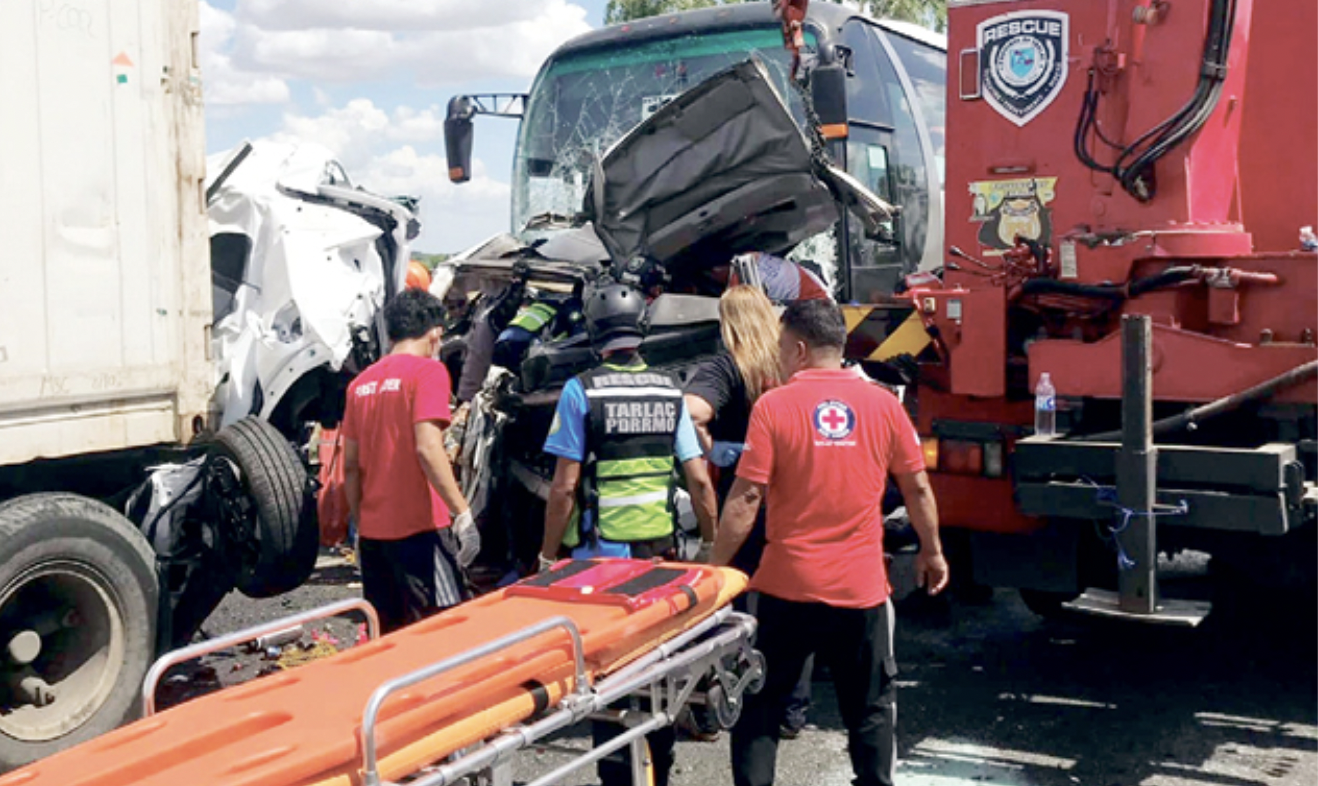LETHAL ROADS

May is Road Safety Month in the Philippines.
This focus on road crashes is arguably all the more vital this year, given the nationwide furore generated by two major road crashes, which occurred just days apart, that killed 12 people and injured dozens more.
The 2023 World Health Organization (WHO) Global Status Report on Road Safety mentions that around 1.19 million people were killed in road crashes worldwide in 2021 – these included 11,096 Filipinos, according to the Philippine Statistics Authority (PSA). The WHO has also long stopped referring to road collisions as “accidents,” given that all of these are entirely preventable.
In this two-part series, we first take a look at the Pangasinan Solid North Transit passenger bus that careened into vehicles queued at the Subic-Clark-Tarlac Expressway (SCTEX) toll plaza in Tarlac City on Labor Day – this collision left 10 dead and 37 injured.
Sitting ducks
According to the Land Transportation Office (LTO) resolution issued on Monday, the bus was traveling northbound with Teodoro Silvallana behind the wheel.
The agency said Silvallana collided into slow-moving cars on the second lane that were waiting to pass through the toll plaza. The ensuing five-car pileup was brutal and lethal – the bus hit a Nissan Urvan, a Kia Sonet, an FAO tractor head, and a Toyota Veloz, instantly sandwiching the occupants like sardines.
Among the dead were eight Seventh-day Adventist Church members who were heading to a children’s camp in Pangasinan – all of their coffins were displayed together this week, with their burials set on Friday.
Meanwhile, a two-year-old boy will grow up never knowing his parents – he was the sole survivor in their mangled family car that killed Philippine Coast Guard (PCG) Seawoman 1 Diane Alinas and her husband. The PCG said it would provide P250,000 financial assistance for the family left behind by their fallen colleague.
Immediately after the crash, Silvallana was found to have zero alcohol in his system, but he refused to undergo a mandatory drug test. He claimed that he fell asleep behind the wheel, leading to the crash.
“The bus crash at SCTEX is the much-feared mass casualty event scenario on an expressway,” said lawyer and Automobile Association of the Philippines (AAP) trustee Robby Consunji in an exclusive interview with Inquirer Mobility.
“The penetration into the passenger compartment was most shocking – the vehicles looked like an accordion,” he added. “Drivers find it hard to admit that falling asleep behind the wheel is even possible. We need to shake the drivers out of denial.”
Government cracks down
The day after the crash, the Land Transportation Franchising and Regulatory Board (LTFRB) issued a 30-day suspension against 15 Pangasinan Solid North Transit units as authorities investigate the company’s vehicles and drivers.
The bus company stopped all of its operations on Saturday and promised to be accountable for the incident. And in its Monday resolution, the LTO revoked Silvallana’s driver’s license and perpetually disqualified him from driving for refusing to undergo the drug test.
In a Monday press conference, Transportation Secretary Vince Dizon announced a department order that requires all public-utility vehicle (PUV) drivers to undergo mandatory drug tests every six months, starting from the date of employment. He added that he will ask the LTO and LTFRB to reduce the maximum driving time for trips from six hours to four hours.
“The specific liability of the driver depends on the findings of the resulting investigation,” said lawyer and Move As One Coalition member Daphne Marcelo in an exclusive interview with Inquirer Mobility.
“Other than the driver and Pangasinan Solid North Transit, we should also be thinking about the responsibility of the other stakeholders, especially those in charge of the management of roads like the government and the private tollway operator, about their part in fatigue management and speed management.”
Better investigations
The SCTEX bus crash is reminiscent of the Dec. 5, 2024 crash near the Katipunan flyover in Quezon City.
Here, a speeding 10-wheeler truck plowed into dozens of cars and motorcycles that had been sitting in traffic in front of Ateneo de Manila University – four were killed and 30 were injured by the mangled mess of metal after the truck allegedly lost braking action.
Consunji said the SCTEX incident strengthens the need for a Philippine Transportation Safety Board (PTSB).
“We hope the authorities thoroughly investigate the crash so that we all learn and do not repeat the mistakes,” he said. “This is a wake-up call to revive the efforts to create an independent government body to investigate transportation incidents.”
President Ferdinand Marcos Jr. vetoed on July 2022, a bill that would have established the PTSB, saying that it would not only duplicate the functions of other agencies, but also cause confusion on which agency would have investigative authority.
Senate Bill No. 1121 revives the push for a PTSB, which would fall under the Office of the President and serve as the primary investigative body in any transportation incident.
Less speed
Meanwhile, Marcelo said the SCTEX bus crash highlights the need to reevaluate existing transport regulations.
“Are there sufficient guidelines on scheduling practices that allow adequate rest for drivers and for companies to monitor and minimize risks relating to their fatigue?” she said. “While there is no single policy that can guarantee absolute safety, the application of the Speed Limiter Act would likely have mitigated the risks involved and potentially saved lives.”
Republic Act 10916 or the “Road Speed Limiter Act of 2016” lapsed into law on July 21, 2016 under the late former President Benigno Aquino III. The measure required all PUVs, except taxis and jeepneys, to have a mechanical, electronic and/or communications system to limit the top speed of the vehicle.
However, implementation and enforcement of the law has been spotty, leading to PUVs that could still drive beyond the maximum speed limit on expressways.
Just how many more dead bodies and orphaned children must we witness before we decide to finally enforce life-saving laws and sound transport regulations?

















